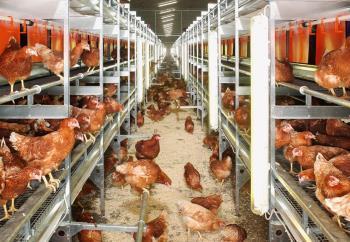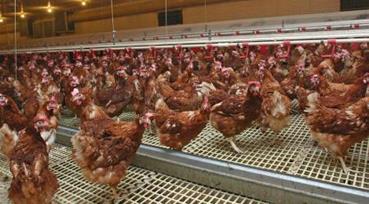EGG-NEWS summarizes and comments on data and trends in the monthly USDA Cage-Free Report. This data is correlated and interpreted in the WeeklyEggPrice and Inventory Report posted on EGG-NEWS mailed on Fridays each week.
 The USDA Cage-Free Report covering March 2024, released on April 1st 2024, documented the complement of hens producing under the Certified Organic Program to be 18.2 million (rounded to 0.1 million), down 0.5 percent from February 2024. The number of hens classified as cage-free (but excluding Certified Organic) and comprising aviary, barn and other systems of housing apparently declined by less than 0.1 percent from February 2024 to an unaltered 106.5 million. Hen numbers posted by the USDA over the 4th quarter of 2023 and especially February 2024 are questioned based on the stated average hen-week production. The number of eggs collected is accepted as accurate but since the value for average weekly production is unacceptably high the denominator reflecting number of hens is probably incorrect. Alternatively if conventional eggs from cages are deceptively marketed as cage-free, assuming an accurate number of hens over a given month, the apparent hen-week value would be incorrectly high. Since the inception of the Cage-Free Report monthly figures have shown erratic fluctuation as during the 1st Quarter of 2024 or alternatively are unchanged in consecutive months. Actual production of eggs is based on the reality of a continuing cycle of placing a predicted number of pullets and depletion of old hens but with limited application of molting for cage-free flocks. The respective numbers of hens claimed for organic and cage-free flocks should reflect chick placements, HPAI depopulation and age-related depletion and should correspond to monthly supply data and inventory extending over successive quarters.
The USDA Cage-Free Report covering March 2024, released on April 1st 2024, documented the complement of hens producing under the Certified Organic Program to be 18.2 million (rounded to 0.1 million), down 0.5 percent from February 2024. The number of hens classified as cage-free (but excluding Certified Organic) and comprising aviary, barn and other systems of housing apparently declined by less than 0.1 percent from February 2024 to an unaltered 106.5 million. Hen numbers posted by the USDA over the 4th quarter of 2023 and especially February 2024 are questioned based on the stated average hen-week production. The number of eggs collected is accepted as accurate but since the value for average weekly production is unacceptably high the denominator reflecting number of hens is probably incorrect. Alternatively if conventional eggs from cages are deceptively marketed as cage-free, assuming an accurate number of hens over a given month, the apparent hen-week value would be incorrectly high. Since the inception of the Cage-Free Report monthly figures have shown erratic fluctuation as during the 1st Quarter of 2024 or alternatively are unchanged in consecutive months. Actual production of eggs is based on the reality of a continuing cycle of placing a predicted number of pullets and depletion of old hens but with limited application of molting for cage-free flocks. The respective numbers of hens claimed for organic and cage-free flocks should reflect chick placements, HPAI depopulation and age-related depletion and should correspond to monthly supply data and inventory extending over successive quarters.
Average weekly production for Certified Organic eggs in March 2024 was down 1.0 percent compared to February 2024 with a questionable average weekly production of 83.8 percent. Down from 84.2 percent in February. Average weekly flock production for cage-free flocks other than Certified Organic was down 0.5 percent in March 2024, also with a questionably high average hen month production of 82.6 percent down from 83.0 percent. Seasonally, younger flocks increase the availability of cage-free and organic eggs in response to pullet chick placements laid down 22 weeks previously in anticipation of peak seasonal demand periods. March 2024 data may have reflected a presumed higher proportion of younger flocks derived from pullet chicks placed during late August and early September 2023 in anticipation of Easter 2024 demand. Since the proportion of pullets according to housing type is not indicated in the monthly USDA Chickens and Eggs report it is not possible to assess the relative sizes of flocks producing under the certified organic label or for other categories. There is no adequate explanation for the high production rate especially if the stated number of hens is lower than actual, especially with undercounted HPAI flock depopulation that appears to be the case at present. This raises the question of possible illegal diversion of caged eggs into the cage-free or organic streams.
|
Flock Size Average
(million hens)
|
March
2024
|
Average
Q1-
2024
|
Average
Q4- 2023
|
Average
Q3 –
2023
|
Average
Q2 –
2023
|
Average
Q1 –
2023
|
|
Certified Organic
|
18.3
|
18.3
|
18.7
|
18.7
|
18.2
|
17.3
|
|
Cage-Free Hens
|
106.5
|
105.7
|
106.4
|
105.4
|
103.2
|
98.1
|
|
Total Non-Caged
|
124.8
|
124.0
|
125.1
|
124.1
|
121.4
|
115.4
|
|
Average Weekly Production (cases)
|
February
2024
|
March
2024
|
|
Certified Organic @ 83.8% hen/day
|
300,309
|
297,225 -1.0%
|
|
Cage-Free @ 82.6% hen/day
|
1,719,872
|
1,711,190 -0.5%
|
|
Total Non-Caged @ 82.8% hen/day
|
2,020,181
|
2,008,415 -0.6%
|
|
Average Nest Run Contract Price Cage-Free Brown
|
$1.68/doz. (Unchanged since September 2023)
|
|
March 2024 Range:
|
$1.35 to $2.35/doz. (unchanged since March 2023)
|
|
FOB Negotiated March price, grade-ready quality, loose nest-run. Price range $2.00 to $2.85 per dozen
|
Average March 2024 Value of $2.50/doz.
($2.60/doz. February 2024)
|
|
Average March Advertised National Retail Price C-F, Large Brown
|
$3.28/doz. March 2024 (4 regions)
(was $3.37 in February 2024)
|
|
USDA Based on 4 Regions, 2,900 stores
Excluding SW, NW, AK and HI.
|
High: $3.44/doz. (SC. 629 stores)
Low: $2.95/doz. (MW. 816 stores)
|
Negotiated nest-run grade-ready cage-free price for March 2024 averaged $2.50 per dozen, down by 6.0 percent from $2.66 per dozen in February 2024, reflecting lower demand relative to supply. The March 2024 advertised U.S. retail price for cage-free eggs over four regions (excluding SW. NW. AK. and HI.) was $3.28 per dozen down 9 cents per dozen from February 2024 over 2,900 stores.
The apparent difference between a recorded average wholesale price of $2.50 per dozen plus a provision of 60 cents per dozen for packaging, packing and transport in relation to the average four-region retail price of $3.28 corresponds to an average retail margin of 5.5 percent (3.4 percent last month) over the average wholesale price for packed eggs delivered to a DC. at $3.11 per dozen. Margins are presumed higher for pastured and other specialty eggs at shelf prices reaching $9.00 per dozen. Chains that are maximizing margins especially on Certified Organic, free-range and pastured categories restrict the volume of sales, ultimately disadvantageous to producers.
Based on the importance of cage-free production, the USDA-AMS issue the Cage-Free report on volumes and prices at monthly intervals for the information of Industry stakeholders. There is obvious doubt as to the accuracy of individual monthly flock numbers especially when reports show a marked change at the end of a quarter or from the previous month without obvious cause, or alternatively when there is no change in the cage-free flock for sequential months.
 According to APHIS data approximately 13 million hens were depopulated during the 4th quarter of 2023 as a result of HPAI. The UEP reported that 47 percent of depopulations have involved cage-free flocks. The approximately 6 million cage-free hens apparently depopulated are not adequately reflected in the recent monthly cage-free reports. The USDA should provide an explanation and appropriate corrections.
According to APHIS data approximately 13 million hens were depopulated during the 4th quarter of 2023 as a result of HPAI. The UEP reported that 47 percent of depopulations have involved cage-free flocks. The approximately 6 million cage-free hens apparently depopulated are not adequately reflected in the recent monthly cage-free reports. The USDA should provide an explanation and appropriate corrections.
It is suggested that USDA should consider a quarterly report with more accurate hen data. This would be more useful to the industry for planning and marketing decisions. Price data is available each week from other USDA reports.
Subscribers are referred to weekly USDA wholesale and retail prices posted in the Egg Price and Inventory Report in EGG-NEWS E-mailed each Friday. The previous Monthly Cage-Free Report is available under the STATISTICS Tab.